Volunteer Stories
This blog comes from David Roberts, Farmer-to-Farmer (F2F) volunteer, a Grazing Land Specialist with the Natural Resources Conservation Service, United States Department of Agriculture.
Rangeland Management with Focus on Nutrition
Traveling to Mongolia has been a great experience for me. It was an opportunity to visit with many nomadic herders and their families to discuss raising livestock.
It also gave me a decent overview of the condition of the rangeland and its management. Since the rangeland is "Open Range" (undivided by fences and ownership) similar to how the American West was one hundred years ago. There could be much to be learned from how America changed from open range to managed rangeland. Education on how rangeland is managed and incorporating the livestock needs would be a better approach than government regulation. I made presentations of livestock in America and Ranch and Farming practices for feeding livestock and pasture/rangeland management.

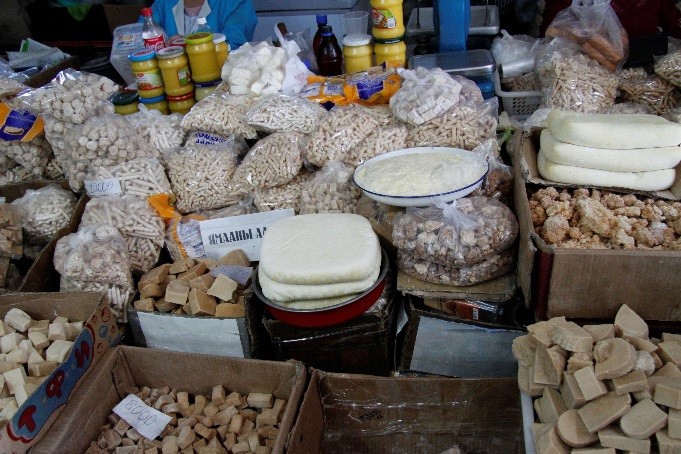

Processing and Marketing of Animal Fiber is a particular opportunity for Mongolian herders. Mongolian cashmere is recognized as some of the best in the world, and numbers of cashmere goats have increased rapidly in the last 3 decades, to provide a source of income for herder families. Many organizations (both international and within Mongolia) have programs on marketing and local processing of cashmere, but more herders (as well as local and national processors) need to be involved in these programs.
An interesting development has been a parallel, though more recent, interest in yak wool. The undercoat of the yaks is a very fine fiber similar to cashmere and has developed as a specialty fiber for processing and sale on the international market. Purebred yaks are most commonly black in color but other colors do occur. Crossing between yak and cattle is common (in Mongolia, the first cross is known as a "khainag") and allows the introduction of a wider range of colors into the resulting crosses. Because white fibers can be dyed to produce fabrics of different colors, white animals are favored over colored ones, and there is a demand for white yak bulls.
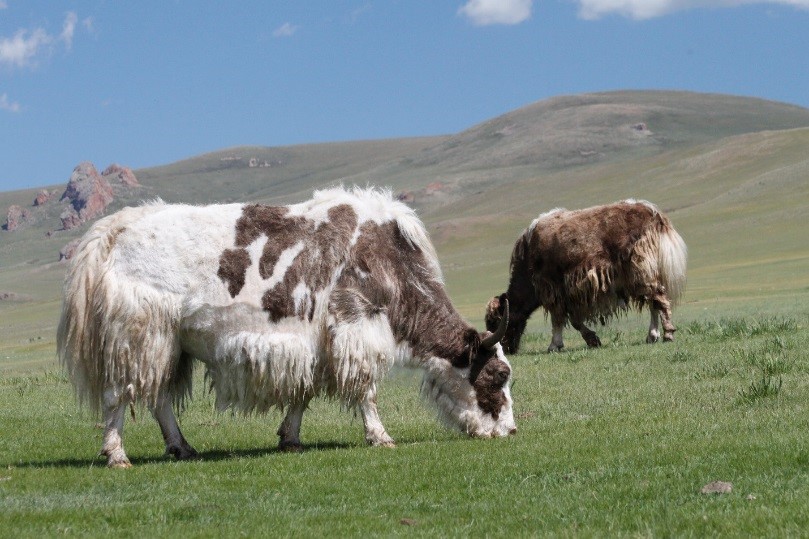
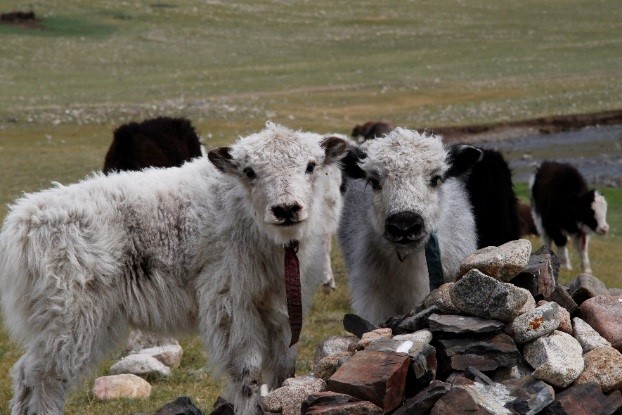

The overgrazing in Ovorkhangai has recently been compounded by a drought. One can imagine the challenges herders face when precipitation is less regular, temperature extremes more common and state of grasslands is deteriorating. When herders organize themselves formally into community-based rangeland management organizations, their knowledge, persistence, and resources can all be pooled to effectively buffer them from many extreme events. That seems to be one of the major missing ingredients in modern Mongolian rangeland management. In a Mongolian context, that's involved everything from pooling resources to dig new wells or cut hay, to coordinating the movement of animals regionally to prevent overgrazing. I recommended the Department of Food and Agriculture in Uvurkhangai aimag that they learn more about community groups with the herders they interact with on a daily basis. This spirit of cooperation and resilience is not new in Mongolia, and that's because it works.
Overgrazing will not be solved by community groups alone. There are structural and economic causes that must be addressed as well. Mongolia will need to secure large and reliable export markets for meat and milk products to facilitate fair prices for livestock. This will incentivize herders to sell animals more regularly, destocking the steppes and reducing grazing pressure. Additionally, the emphasis must be placed on the quality of production animals rather than the quantity. More work will need to be done by veterinarians and geneticists. Veterinarian assistance is needed to mitigate the abundance of zoonotic diseases such as rabies and brucellosis in Mongolia. Livestock geneticists may be able to help develop animals with more marketable meat characteristics, but will need to do so without compromising the animals' ability to survive in Mongolia's incredibly challenging environment.
The future, I believe, will be bright in Mongolia in spite of these challenges. The people I had the privilege of meeting there were an amazing combination of toughness, generosity, intelligence, and wisdom, and with these characteristics, its easy to imagine them creating a better future for their children and the grasslands. I am grateful to DSI, Dem Ololt, my host family in Arvaikheer, and the herders I met (especially Tumuruu) for their hospitality. I very much hope to return someday, to ride herd with Tumuruu and his family again, to learn from some of the best herders in the world, and to contribute whatever I can to preserving their way of life and the grasslands of beautiful Mongolia.
Opportunities and challenges for sustainable livestock development in Mongolia
Forage production was another reason for the assignment and we visited several potential sites to produce forage for hay. In the US, federal government established the Homestead Act allowing farms to be established in the West. The best land was homestead by farmers displacing the livestock herders. I gave a presentation on the types of forages that could be produced in the region.
Raising livestock in America, the issues and challenges are similar to issues in Mongolia. One difference between the two countries is how livestock is sold. In Mongolia livestock is sold by the head and/or by weight where as in America livestock is sold by quality grades. Quality animals need good forage which would have herders shift towards improving forage production on the rangeland. Changes in the market system would help improve both the quality and quantity of the forage the rangeland produces.
Chimgee.D, Professor at National University of Mongolia, and I discussed developing a handbook describing techniques to improve rangeland through management. We will be working on this together during the next several months.
Another concern is with irrigation and the groundwater table. As the amount of land used for forage production increases, the demand for irrigation water increases resulting in the groundwater table lowering. Uvurkhangai aimag where the assignment took place is prone to soil wind erosion and good conservation practices are needed to prevent the loss to wind erosion. Perennial forage species are more suited than annuals species for this reason.
I enjoyed working with herders and farmers in Mongolia. I shared with them how I used to live when I worked on cattle ranches. Moving up into the Rocky Mountains in the summer and then back down onto the Desert for the winters and there were many similarities in our lifestyles. These people have such a great outlook on life, happy with their lifestyle and proud of who they are. After I returned home and back at my work; I am reflecting on my experiences in Mongolia and sorting through what is really important in life.
New Challenges to an Ancient Lifestyle
Posted by Shayan Ghajar, Farmer-to-Farmer (F2F) volunteer, a farmer and doctoral student in the Department of Crop and Soil Environmental Sciences, Virginia Tech
Posted by David Notter, Farmer-to-Farmer (F2F) volunteer, professor emeritus in the Department of Animal and Poultry Sciences, Virginia Tech
The DSI - USAID Farmer-to-Farmer Program began with a fact-finding and program-development visit to Uvurkhangai aimag and was supported by Virginia Cooperative Extension at Virginia Tech and the Uvurkhangai Department of Food and Agriculture. The objectives of the assignment were to identify high-priority areas for future volunteers. Recommendations are discussed below.
Sustainable Commercial Dairying was an area of particular emphasis, given the central role of dairy products in the Mongolian diet and society. Multi-species dairying involving cattle (European, yak, and their crosses), mares, sheep, and goats is widespread and an important source of income for herder families.
Many herders now have simple milking sheds for winter milking. Animals are packed together in a small space in the shed for milking, to capture body heat and make milking more comfortable in often bitterly cold conditions. These sorts of simple milking sheds are typical across the country.
Mongolia's rangelands are an unfenced expanse of undulating hills covered in grasses, livestock, and the spangled shadows of clouds gently drifting overhead. For a rangeland ecosystem scientist, its heaven. For a nomadic herder, its home. And for the Mongolian government, it's an economic boon. However, all three of these groups recognize that the steppes of Mongolia are facing a profound challenge: overgrazing.
Recent rangeland assessments conducted by combined teams of American & Mongolian rangeland scientists found widespread overgrazing impacts on the grassland including Uvurkhangai Aimag where Development Solutions International's Farmer to Farmer program helps herders to increase their productivity and profitability by transferring their business and livestock processing skills that will yield sustainable economic results. Volunteers from Virginia Tech share their expertise on livestock, pasture land and animal health management and engage formal and informal training on innovative livestock methods and technologies for government officials, university students, cooperatives and individual herders in Uvurkhangai aimag. I have a Masters in Rangeland Ecosystem Science from Colorado State University, and my research focuses on livestock production on native grasslands with the Department of Crop & Soil Environmental Sciences at Virginia Tech.


There is a particular need to identify reliable, low-cost mechanized milking equipment. The demands placed on the women who normally do the milking to increase production, milk more animals, and extend the milking season almost inevitably leads to eventual joint damage. Now that solar panels and associated small appliances have become commonplace among herder families, the use of small, multispecies milking machines seems to be a logical next step. However, training on the use, maintenance, and cleaning of the machines will be essential to maintain sanitation of collected milk and avoid transmission of disease among animals within the herd.
Milking of mares is widespread, and mildly fermented mares' milk ("airag") is a unique Mongolia product, with a central role in the hospitality of Mongolian herders.
Interest in extending the milking season of cattle throughout the winter to take advantage of previously underserved markets is growing but requires better animal housing, more use of hay and other supplemental feeds, and the identification of dairy animals that can produce more milk (to justify the greater investment in feed, labor, and housing) while still being suitably adapted to the often severe conditions during the Mongolia winter. Areas of future emphasis will therefore include options for economical housing, small-scale hay-making, development of more reliable water sources, and strategies for processing of dairy products to even-out supplies and cope with high production but lower demand (for example, from schools) during the summer grazing season.
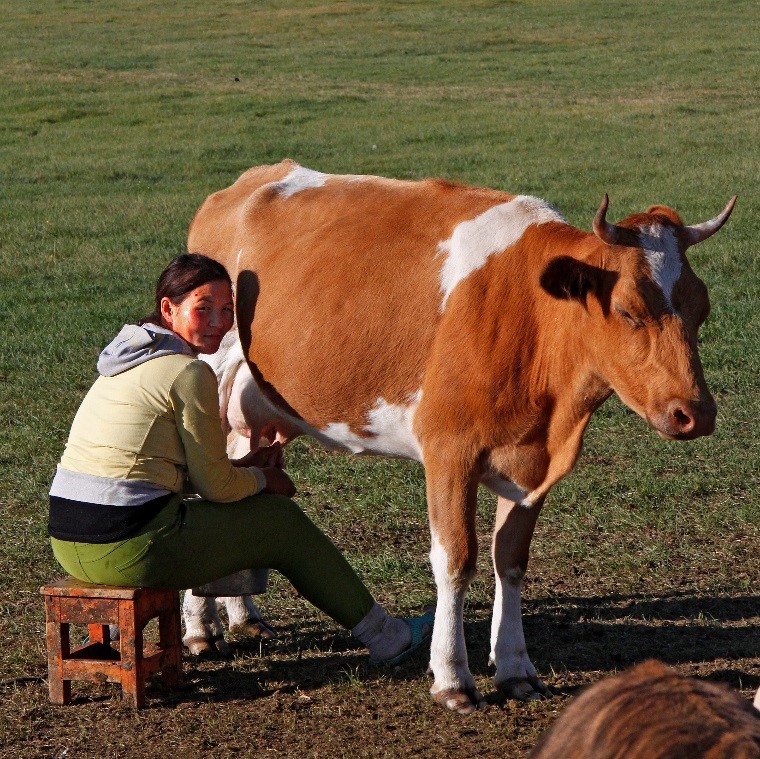
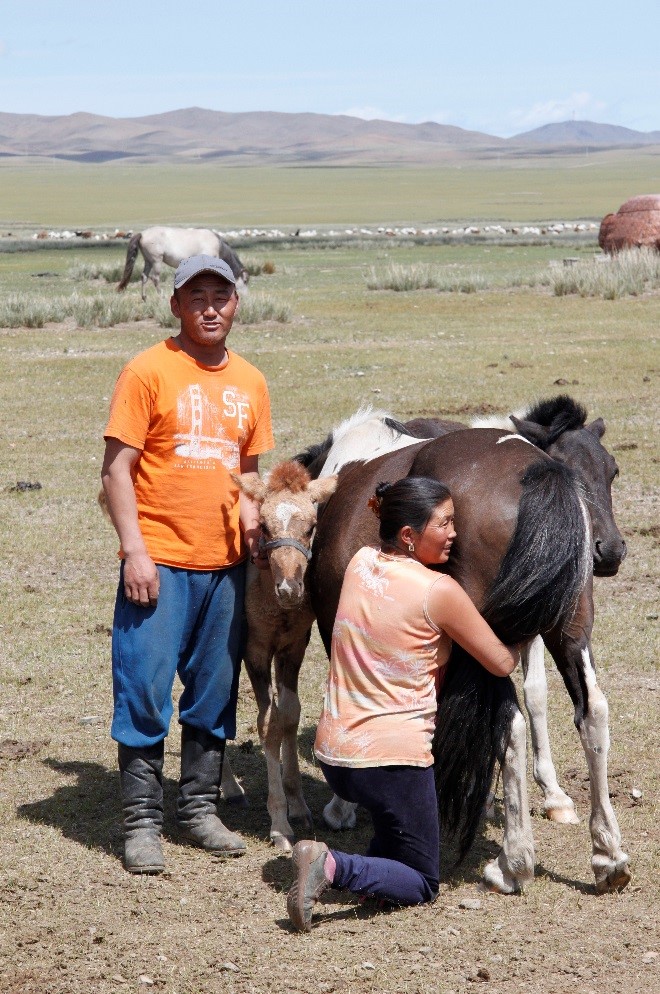
Processing and Marketing of Meat and Dairy Products is another area of emphasis. Increasing urbanization requires an expanded capacity to deliver meat and milk products from the grazing lands to the cities and towns. Traditional markets are appropriate to serve local communities but better sanitation and packaging could support delivery of products to more distant (and potentially more lucrative) markets, reduce seasonality of product availability, and improve product uniformity.
The importance of sanitation and proper handling of meat and dairy products chain is well-understood by producers, processers, and consumers. However, surveys conducted in 2011 and2014 indicated that the incidence of Brucellosis in Mongolia is relatively high in both dairy animals and herder families. Outbreaks of Foot and Mouth Disease are becoming less frequent, but remain persistent, and place significant constraints on the development of international markets for meat products. Better control of these two diseases is a priority for Mongolian livestock producers.

Dairy Production and Management
This blog comes from Mark Teets, Farmer-to-Farmer (F2F) volunteer, a Dairy Specialist and a Farmer from Aurora, West Virginia
My name is Mark Teets and I was born to a farming family in West Virginia. I was raised on a dairy farm where my father and grandfather had once delivered milk door to door. I took over the dairy when I was 19 years old, becoming the top producing dairy in West Virginia and continued to dairy farm for 25 years. After my children left for college, I left the dairy business to begin raising sheep, a less labor-intensive production. I have raised lamb for the last 15 years, working closely with West Virginia University's (WVU) reproductive physiology program.
I was encouraged by my WVU contacts to pursue an opportunity to travel to Mongolia to work with dairy. I was selected to take part in the program but did not really know what to expect of the experience. I am told Mongolia has 3 million people and 66 million livestock. We showed how we do our records based on electronic tags in each animal. They expressed concerns that the herders had little records to go on. We shared information on CIDRs as inserts for sheep and how they could use them to improve the sheep flock. I gave a presentation about milk production in the United Sttes from the smaller farms to the consumer.
Overall, I was very pleased with the organization of the programs and my travels. I found quickly that the people of Mongolia, in particular the government officials, were eager to listen and work together. I knew very little Mongolia and the people there and even less of their agricultural practices. One thing that really stood out to me was the vastness of the grazing area and the large number of livestock. This concerned me because of the extreme problem of over grazing the land. We talked about this problem and several ideas to improve grazing practices.
Over grazing of 65 million livestock: The highlight of my trip was spending time working and living alongside the herders. I spent several nights in gers, ate meals around the traditional bowl of Mongolian meat, and traded life experiences with my hosts. I tried new foods and ingested more varieties of milk than I ever knew existed and from more than just cows. I got to ride Mongolian horses and saw camels and other livestock.
Livestock, I learned, meant more than one species of animal to the herders there where I was accustomed to raising one variety of animal. Livestock to them included sheep, goats, cows, horses, and camels. I experienced wonderful hospitality and left Mongolia with many new friends who I look forward to keeping in touch with thanks to Facebook.
There were several immediate changes that my visit encouraged regarding the agricultural practices of the herders. We encouraged the herders to begin using the California Mastitis Test to improve the quality of milk by checking white cell counts and to use more sanitary practices while milking and storing. We distributed sample kits of the CMT, gloves, CIDRs, and hoof rasps. It is our hope that our visit will bring some long-term improvements in feeding, nutrition, and marketing.
One of the problems for the herders is lack of water for their livestock. Great experience for me as I was able to be out with the herders as they did their work. They are into horses and the herder we visited is an award-winning horseman. Nearby was a well that I am told that waters about 4000 head of livestock a day. The water made a huge difference. Not only with the horse but he had cows, sheep and goats. It is fortunate that the family is closer to a well, water shortage is a huge problem for herders.
My visit to Mongolia not only impacted my life, it also sparked an interest in my community. Being a pastor of a church, my three week absence was noticed by my church family and excited the curiosity of the community. They will be hosting a community wide event featuring my presentation of pictures and experiences. The members of the county farm bureau are also interested in hosting an event. I hope by sharing it will encourage others to participate in programs like this and I hope to continue helping where I am able.
 v
v


